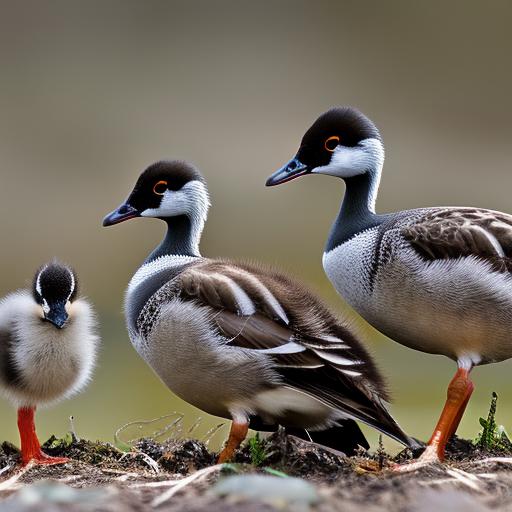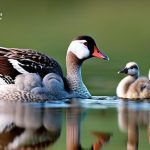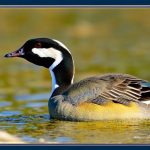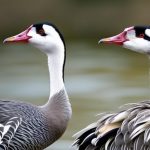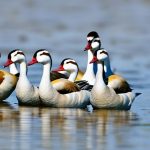Canadian geese, also known as Canada geese, are a species of waterfowl that are native to North America. These majestic birds are known for their distinctive black heads and necks, white cheeks, and brown bodies. They are a common sight in many parts of Canada and the United States, where they can be found in a variety of habitats, including lakes, rivers, and marshes. Canadian geese are monogamous birds, and they form strong pair bonds that can last for life. They are also known for their strong migratory instincts, and they can often be seen flying in V-shaped formations as they travel to and from their breeding grounds.
Reproduction is an important part of the life cycle of Canadian geese, and it is a process that is both fascinating and complex. The egg-laying and hatching process of Canadian geese is a critical stage in their reproductive cycle, and it is one that is essential for the survival of the species. In this article, we will explore the egg-laying and hatching process of Canadian geese in detail, including the factors that can affect the incubation period and the care that is required for the eggs and goslings during this time.
The Egg-laying Process of Canadian Geese
The egg-laying process of Canadian geese typically begins in the early spring, when the birds return to their breeding grounds after their winter migration. Female Canadian geese will typically lay a clutch of 4-7 eggs, with one egg being laid every 1-2 days. The eggs are usually laid in a shallow depression that is lined with down feathers and other soft materials, and the female will continue to lay eggs until the clutch is complete. Once the clutch is complete, the female will begin the incubation process, which is essential for the development of the embryos inside the eggs.
The eggs of Canadian geese are typically large and oval-shaped, with a smooth and slightly glossy surface. They are usually a pale cream or off-white color, and they are designed to provide protection and nourishment for the developing embryos. The eggs are also equipped with a porous shell that allows for the exchange of gases, which is essential for the development of the embryos. Once the eggs are laid, the female will begin the incubation process, which involves sitting on the eggs to keep them warm and turning them regularly to ensure that they develop properly. This process is essential for the survival of the embryos, and it is a critical stage in the reproductive cycle of Canadian geese.
Incubation Period of Canadian Geese Eggs
The incubation period of Canadian geese eggs typically lasts for around 25-28 days, although this can vary depending on a number of factors, including the temperature and humidity of the environment. During this time, the female will remain on the nest almost constantly, only leaving briefly to feed and drink. The male will also help to protect the nest and the eggs, and he may take over the incubation duties for short periods of time to allow the female to rest and recuperate. The incubation period is a critical stage in the development of the embryos, and it is essential for the survival of the eggs and the future goslings.
During the incubation period, the female will use her body heat to keep the eggs warm, and she will also turn the eggs regularly to ensure that they develop properly. This process is essential for the survival of the embryos, as it helps to ensure that they receive the oxygen and nutrients that they need to develop. The female will also use her brood patch, a bare patch of skin on her abdomen, to provide additional warmth and protection for the eggs. This process is essential for the survival of the embryos, and it is a critical stage in the reproductive cycle of Canadian geese.
Factors Affecting the Incubation Period
The incubation period of Canadian geese eggs can be affected by a number of factors, including the temperature and humidity of the environment. Warmer temperatures can speed up the development of the embryos, while cooler temperatures can slow it down. Similarly, higher humidity levels can help to ensure that the eggs do not dry out, while lower humidity levels can increase the risk of the eggs becoming dehydrated. These factors can have a significant impact on the development of the embryos, and they can affect the length of the incubation period.
In addition to environmental factors, the incubation period of Canadian geese eggs can also be affected by the health and condition of the female. A female that is in poor health or condition may not be able to provide the necessary care and warmth for the eggs, which can affect the development of the embryos. Similarly, the presence of predators or disturbances near the nest can also affect the incubation period, as they can cause the female to leave the nest and abandon the eggs. These factors can have a significant impact on the survival of the eggs and the future goslings, and they are important considerations for anyone who is observing or studying the hatching process of Canadian geese eggs.
Signs of Imminent Hatching
As the end of the incubation period approaches, there are several signs that indicate that the eggs are about to hatch. One of the most obvious signs is the behavior of the female, who may become more restless and vocal as the hatching process approaches. She may also spend more time standing and stretching, and she may begin to pluck at the down lining of the nest in preparation for the arrival of the goslings. In addition, the eggs themselves may begin to make faint peeping sounds as the embryos inside them become more active and start to break through the shell. These signs are all indications that the hatching process is imminent, and they are important for anyone who is observing or studying the hatching process of Canadian geese eggs.
Another sign of imminent hatching is the appearance of small cracks or pips in the shells of the eggs. These cracks are made by the embryos inside the eggs as they use their egg tooth, a small projection on the tip of their beak, to break through the shell. Once the embryos have made these cracks, they will continue to work at them until they are able to push their way out of the shell. This process can take several hours or even a day or more, and it is an important stage in the hatching process. Once the goslings have hatched, they will be wet and exhausted, and they will need time to rest and dry off before they are able to leave the nest and begin their new lives.
Caring for Canadian Geese Eggs During Incubation
During the incubation period, it is important to provide the female Canadian goose with the care and protection that she needs to successfully hatch her eggs. This includes providing her with a safe and undisturbed nesting site, as well as access to food and water so that she can maintain her health and condition. It is also important to minimize disturbances near the nest, as these can cause the female to leave the eggs and abandon them. In addition, it is important to monitor the temperature and humidity of the environment to ensure that the eggs are able to develop properly. This may involve providing additional insulation or protection for the nest, especially if the weather is particularly cold or wet.
It is also important to provide the female with the support and protection that she needs to successfully hatch her eggs. This may involve providing her with additional food and water, as well as protecting her from predators and disturbances near the nest. It may also involve providing her with additional nesting materials, such as down feathers and other soft materials, to help keep the eggs warm and protected. By providing the female with the care and protection that she needs, it is possible to increase the chances of a successful hatching and the survival of the future goslings.
The Hatching Process of Canadian Geese Eggs
The hatching process of Canadian geese eggs is a fascinating and complex event that is essential for the survival of the species. As the embryos inside the eggs become more active and start to break through the shell, they will continue to work at the cracks until they are able to push their way out. This process can take several hours or even a day or more, and it is an important stage in the development of the goslings. Once the goslings have hatched, they will be wet and exhausted, and they will need time to rest and dry off before they are able to leave the nest and begin their new lives.
Once the goslings have hatched, they will be completely dependent on their parents for food, warmth, and protection. The female will continue to provide care and protection for the goslings, while the male will help to defend the nest and the young from predators and other threats. The goslings will also need to be kept warm and dry, and they will need to be fed a diet of grasses, grains, and other plant materials to help them grow and develop. This process is essential for the survival of the goslings, and it is a critical stage in the reproductive cycle of Canadian geese.
Post-Hatching Care for Canadian Goslings
After the goslings have hatched, it is important to provide them with the care and protection that they need to survive and thrive. This includes providing them with a safe and secure environment, as well as access to food and water so that they can grow and develop. It is also important to protect them from predators and other threats, as they are vulnerable and defenseless in the early days of their lives. In addition, it is important to monitor their health and condition to ensure that they are growing and developing properly. This may involve providing them with additional food and water, as well as protecting them from disturbances and other threats.
It is also important to provide the goslings with the support and protection that they need to successfully fledge and leave the nest. This may involve providing them with additional food and water, as well as protecting them from predators and other threats. It may also involve providing them with additional nesting materials, such as down feathers and other soft materials, to help keep them warm and protected. By providing the goslings with the care and protection that they need, it is possible to increase the chances of a successful fledging and the survival of the future generations of Canadian geese.
Importance of Understanding the Hatching Process
Understanding the hatching process of Canadian geese eggs is important for a number of reasons. First and foremost, it is essential for the survival of the species, as it is a critical stage in the reproductive cycle of Canadian geese. By understanding the hatching process, it is possible to provide the care and protection that the female and the goslings need to successfully hatch and thrive. In addition, understanding the hatching process can also provide valuable insights into the behavior and biology of Canadian geese, as well as the factors that can affect their reproductive success.
Understanding the hatching process of Canadian geese eggs can also provide valuable information for conservation and management efforts. By monitoring the hatching process, it is possible to assess the health and condition of the population, as well as the success of breeding efforts. This information can be used to inform conservation and management strategies, as well as to identify potential threats and challenges that may be affecting the population. By understanding the hatching process, it is possible to develop effective strategies for the conservation and management of Canadian geese, and to ensure that they continue to thrive for generations to come.
Conclusion and Recommendations for Observing Canadian Geese Egg Hatching
In conclusion, the egg-laying and hatching process of Canadian geese is a fascinating and complex event that is essential for the survival of the species. By understanding the hatching process, it is possible to provide the care and protection that the female and the goslings need to successfully hatch and thrive. It is also possible to provide valuable insights into the behavior and biology of Canadian geese, as well as the factors that can affect their reproductive success. By monitoring the hatching process, it is possible to assess the health and condition of the population, as well as the success of breeding efforts. This information can be used to inform conservation and management strategies, as well as to identify potential threats and challenges that may be affecting the population. By understanding the hatching process, it is possible to develop effective strategies for the conservation and management of Canadian geese, and to ensure that they continue to thrive for generations to come.
For those who are interested in observing the hatching process of Canadian geese eggs, it is important to do so with care and respect for the birds and their environment. It is important to minimize disturbances near the nest, as these can cause the female to leave the eggs and abandon them. It is also important to observe from a safe distance, as the presence of humans can cause stress and anxiety for the birds. By observing with care and respect, it is possible to gain valuable insights into the behavior and biology of Canadian geese, as well as the factors that can affect their reproductive success. By doing so, it is possible to contribute to the conservation and management of Canadian geese, and to ensure that they continue to thrive for generations to come.
Meet Walter, the feathered-friend fanatic of Florida! Nestled in the sunshine state, Walter struts through life with his feathered companions, clucking his way to happiness. With a coop that’s fancier than a five-star hotel, he’s the Don Juan of the chicken world. When he’s not teaching his hens to do the cha-cha, you’ll find him in a heated debate with his prized rooster, Sir Clucks-a-Lot. Walter’s poultry passion is no yolk; he’s the sunny-side-up guy you never knew you needed in your flock of friends!

